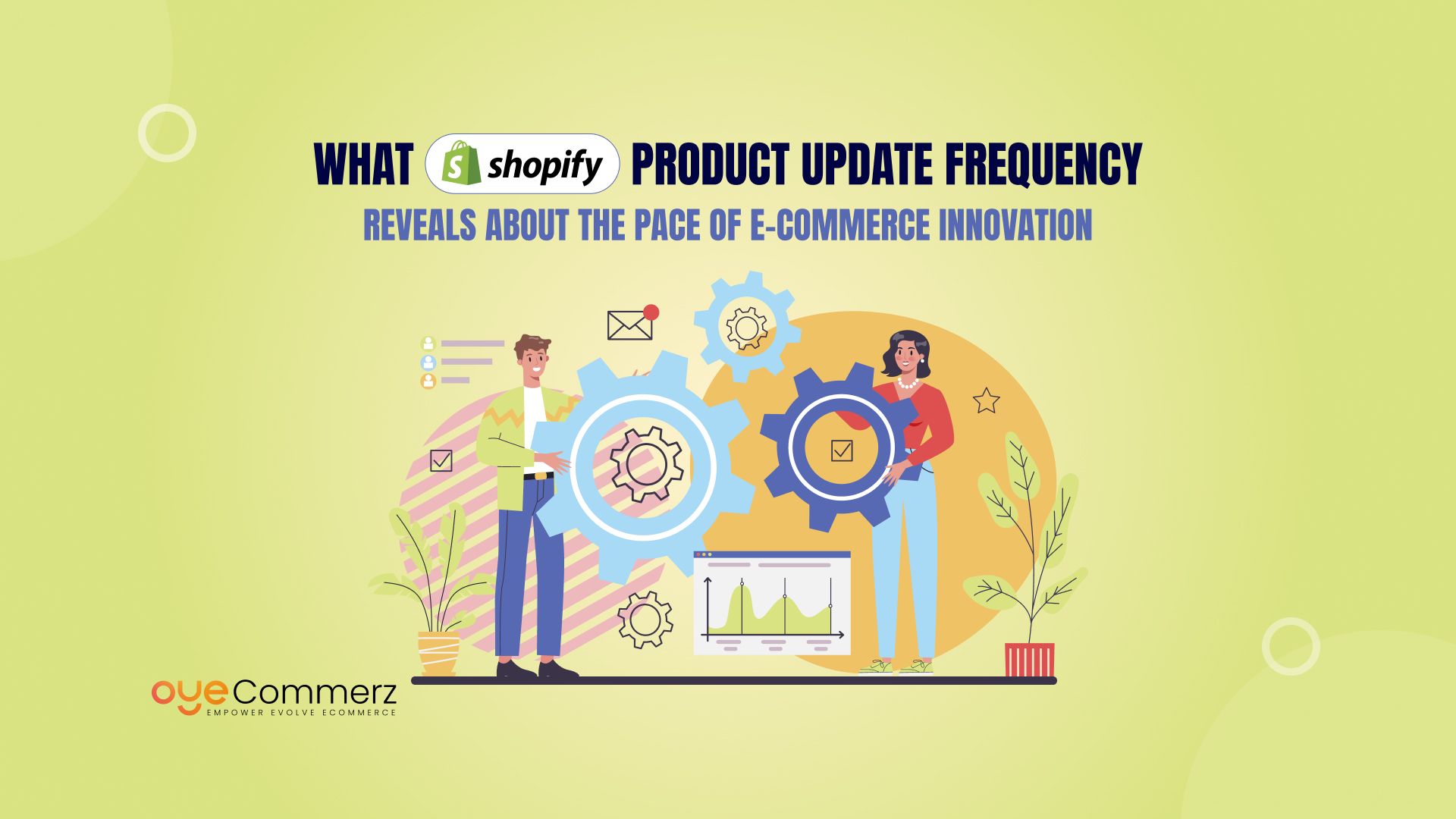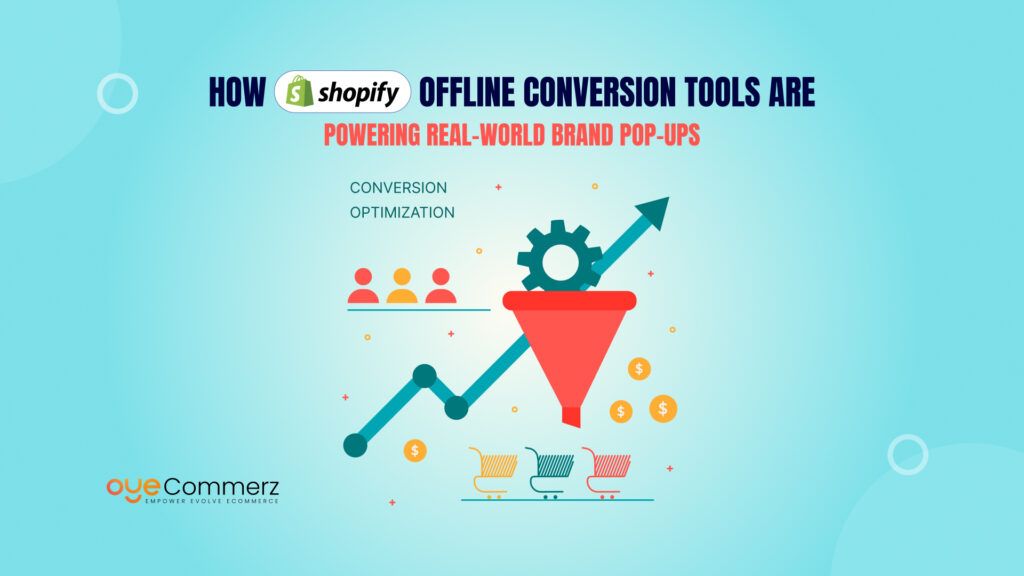Do you know? In 2023, Shopify released over 100 product updates in its Winter Edition alone, showcasing the platform’s commitment to continuous innovation. This impressive Shopify’s product update frequency reflects the accelerating pace of e-commerce innovation, where staying ahead is crucial for success.
These updates span various aspects, including AI-powered tools, enhanced checkout experiences, and expanded Shopify Services, all designed to empower merchants to adapt swiftly to market changes. For U.S. businesses, leveraging these frequent enhancements isn’t just beneficial, it’s essential. As consumer expectations evolve rapidly, the ability to implement new features and services promptly can be the difference between leading the market or falling behind.
This blog delves into how Shopify’s relentless update cycle impacts merchants and offers insights on harnessing these advancements to maintain a competitive edge. Understanding and utilizing the rhythm of Shopify’s innovations can position your brand to thrive in the dynamic world of e-commerce.
The E-Commerce Challenge in 2025
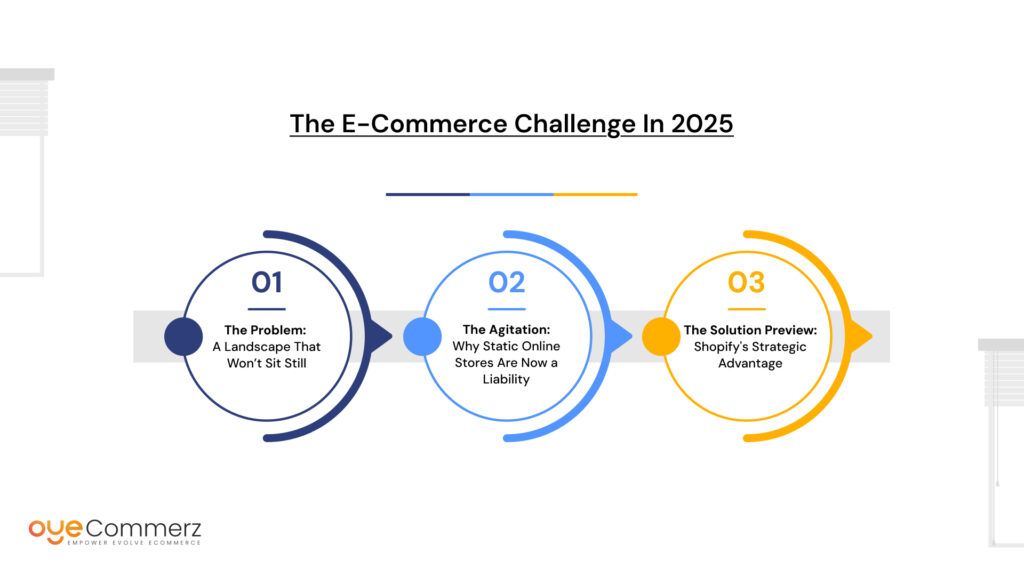
The digital shelf has never been more crowded. In 2025, the e-commerce space isn’t just competitive, it’s chaotic. Brands are not just fighting for attention; they’re battling for survival in an environment that shifts faster than ever. With every swipe and click, consumer expectations evolve. And with them, the pressure on online businesses grows.
The Problem: A Landscape That Won’t Sit Still
The challenges are no longer about “getting online.” It’s about staying relevant:
- Consumer behavior is increasingly unpredictable. Shoppers are influenced by viral trends, new platforms, and shifting economic conditions.
- Expectations are sky-high. Today’s buyers want personalized experiences, lightning-fast load times, and seamless mobile functionality, every time.
- Attention spans are shrinking. You have seconds to impress or you’re out of the cart, out of the mind.
The Agitation: Why Static Online Stores Are Now a Liability
Here’s the hard truth: Static websites and outdated platforms no longer cut it.
- If your online store hasn’t evolved in the last six months, it’s already behind.
- Slow response to consumer demands? That’s a conversion killer.
- Delayed integrations with the latest tools or payment systems? That’s lost revenue.
In an age where the norm is rapid testing and immediate execution, rigidity isn’t just inefficient, it’s dangerous. Legacy systems and long development cycles now act as dead weight. You’re not just missing opportunities, you’re handing them to your faster-moving competitors.
The Solution Preview: Shopify’s Strategic Advantage
This is where Shopify flips the script.
Shopify understands the speed at which the game will be played in 2025. That’s why it’s merchants are equipped with:
- A platform that evolves constantly
- Easy access to new features and tools without needing a full development team
- Ecosystem-wide updates that improve customer experience, operations, and conversion rates
Whether you’re running a one-person store or managing thousands of SKUs, Shopify Services help you keep pace. You’re not reinventing the wheel, you’re upgrading it, regularly.
The Underlying Truth
Shopify’s product update frequency isn’t about adding fluff. It’s about survival. If you’re not evolving with the platform, your competition is, and they’ll beat you to your customer’s wallet. Staying static isn’t neutral; it’s falling behind.
In 2025, success favors the adaptable. Shopify gives you the tools, but it’s on you to use them.
Shopify’s Product Update Frequency: The Secret Weapon
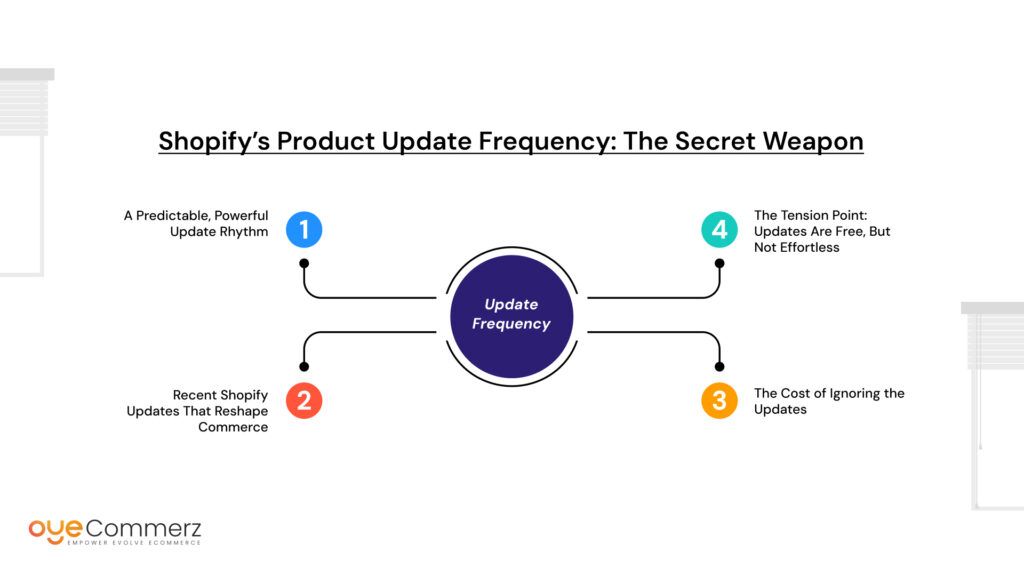
Every business talks about innovation. Shopify proves it, on a timeline you can set your watch by.
Unlike legacy platforms that release updates sporadically or lock improvements behind expensive development cycles, Shopify is in perpetual motion. Its product update frequency is strategic, structured, and laser-focused on merchant success.
A Predictable, Powerful Update Rhythm
Shopify has designed an update cadence that doesn’t just react to change—it drives it:
- Shopify Editions (twice a year): Major updates announced in Winter and Summer Editions, showcasing platform-wide enhancements.
- Continuous feature rollouts: Weekly and monthly rollouts improve usability, conversion rates, and backend performance, quietly but impactfully.
- Performance upgrades: Core Web Vitals improvements, mobile-first refinements, and checkout speed enhancements happen regularly.
- Ecosystem integrations: From Shopify’s app marketplace to native integrations with social commerce platforms, everything is built for agility.
These aren’t cosmetic updates. They’re strategic, designed to directly address pain points merchants face in real time.
Recent Shopify Updates That Reshape Commerce
Take a closer look at the types of updates Shopify has been rolling out, and it becomes clear how transformative they are:
- AI-generated content tools: Generate product descriptions and blog posts using built-in AI, saving hours in copywriting and improving SEO.
- One-page checkout: Shopify’s lightning-fast checkout process improves speed and reduces abandonment.
- Cross-border commerce tools: Currency switching, duty and tax estimates, and international pricing give U.S. merchants a global edge.
- POS innovations: Offline selling just got smarter, with better syncing, analytics, and customizations for hybrid businesses.
These tools aren’t “nice to have.” They’re conversion accelerators, time savers, and profit boosters.
The Cost of Ignoring the Updates
Here’s the reality: If you’re not tracking and leveraging these updates, you’re leaving revenue on the table.
- You miss features that could reduce customer friction.
- You delay adopting tools that could double your efficiency.
- You allow competitors, who are paying attention, to outpace you.
Legacy CMS platforms like WooCommerce or Magento simply can’t match this velocity. Their update cycles are slower, require more manual implementation, and often demand costly dev work. Shopify eliminates that drag, if you engage with it.
The Tension Point: Updates Are Free, But Not Effortless
Yes, Shopify’s updates are free, but they’re not free of effort.
To benefit from them, merchants must:
- Stay informed through Shopify Editions announcements and release notes.
- Actively test and apply relevant features to their stores.
- Train staff or partners on new tools like AI copy generators or international selling options.
Shopify Services give you the platform, but engagement is your responsibility. Ignoring these tools won’t break your business overnight, but over time, the compounding effect of missed innovations is very real.
Shopify’s product update frequency is the secret weapon, but only for those who choose to wield it.
The Technical Backbone- How Shopify Executes Innovation
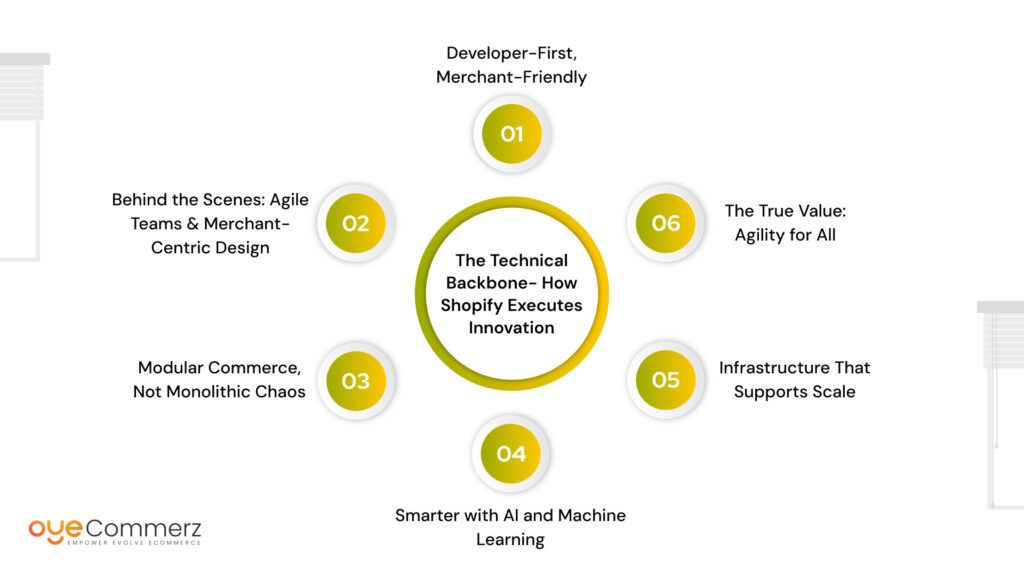
It’s easy to admire Shopify’s rapid innovation from the outside. But under the hood, there’s a deeply engineered system that powers its seamless, consistent evolution. For merchants, especially those without deep tech backgrounds, the true magic is this: Shopify makes world-class innovation feel effortless.
Let’s break down how Shopify delivers at such speed, without disrupting merchants’ workflows.
Developer-First, Merchant-Friendly
Shopify is built with developers in mind but designed so that non-developers can reap the rewards:
- Robust APIs and GraphQL endpoints allow developers to customize, extend, and connect Shopify with virtually any system.
- Shopify CLI (Command Line Interface) streamlines theme development, scripting, and app deployment.
- Hydrogen and Oxygen support headless commerce, giving developers full creative control while Shopify handles hosting and infrastructure.
Even if you’re not coding, your agency or tech partner has a powerful toolkit to build cutting-edge experiences quickly and securely.
Behind the Scenes: Agile Teams & Merchant-Centric Design
Shopify doesn’t just guess what merchants need, it listens.
- Agile development teams iterate fast, based on live performance data and merchant feedback.
- Features are tested through A/B experiments, ensuring they deliver real value before full release.
- Beta testing cycles involve real merchants, closing the gap between tech innovation and business application.
This approach ensures updates are not just fast, they’re purposeful, tested, and impactful.
Modular Commerce, Not Monolithic Chaos
One of Shopify’s core advantages is its modular commerce architecture. Unlike traditional platforms that require sweeping overhauls for every update, Shopify allows for:
- Progressive adoption of features, you can add, skip, or test new tools as needed.
- Selective integration, customize your tech stack without waiting on full-version updates.
This keeps your store agile without creating disruption or downtime. Whether you’re adopting one feature or twenty, your store evolves on your terms.
Smarter with AI and Machine Learning
Shopify integrates AI in powerful but intuitive ways:
- Product recommendation engines use machine learning to boost average order value.
- Fraud detection tools assess transaction risk in real time.
- Predictive analytics help merchants plan inventory and marketing with greater accuracy.
These tools work automatically behind the scenes, offering major performance boosts without requiring advanced expertise.
Infrastructure That Supports Scale
Shopify’s technical upgrades are not just skin deep:
- Shopify Functions allow deeper backend customizations without compromising stability.
- Checkout extensibility gives developers the ability to optimize final purchase steps, crucial for reducing cart abandonment.
- Global infrastructure improvements (like faster servers and CDN expansions) ensure lightning-fast load times anywhere in the world.
The True Value: Agility for All
What makes Shopify exceptional isn’t just its technology, it’s how accessible that technology is.
With Shopify Services constantly improving and an architecture that empowers rather than overwhelms, non-technical merchants can operate with the technical agility of major retail brands. Whether you’re a startup or scaling fast, the power to adapt, test, and win is in your hands, without needing a full dev team.
Shopify’s product update frequency is backed by a serious technical foundation. But the best part? You don’t have to understand the code to benefit from the innovation.
What This Means for U.S. Merchants and Brands (Application & Impact)
Shopify’s relentless update cycle isn’t just a flex, it’s a competitive edge, especially for U.S.-based merchants navigating one of the world’s most demanding e-commerce markets. In a space where speed, personalization, and omnichannel presence are no longer perks but expectations, the real winners are those who can pivot fast, launch faster, and sell smarter.
The Direct Impact on U.S. Brands
Shopify’s product update frequency delivers measurable advantages to American businesses, large and small:
- Faster Customer Experiences: Every update, from checkout speed improvements to mobile-first themes, translates into shorter load times, quicker decisions, and higher conversion rates.
- More Sales Channels: Shopify’s constant integrations with TikTok, YouTube Shopping, Facebook, Instagram, and Google expand your reach in real-time.
- Smarter Personalization: AI-powered features like smart product recommendations and personalized email flows boost engagement and loyalty.
In a saturated U.S. retail market, those improvements aren’t just helpful, they’re essential.
Unlocking New Opportunities
Shopify’s updates don’t just optimize existing tools, they open new revenue paths. For U.S. merchants looking to scale or diversify, here are three powerful examples:
- Shop Pay Installments: Offer flexible payment plans to increase cart size and reduce friction for big-ticket items.
- Multi-Currency and Localized Selling: Shopify Markets lets American merchants serve global customers with local currency, pricing, and duties calculated automatically.
- B2B Functionality: Advanced wholesale features, custom pricing, and B2B portals let U.S. brands sell to businesses as easily as to individual consumers.
These aren’t premium add-ons. They’re built directly into Shopify’s core, rolled out and refined through its update cadence.
Operational Agility When It Matters Most
Shopify’s ecosystem is built for flexibility, something U.S. brands have learned the hard way through:
- Sudden shifts in consumer demand
- Viral product moments that require rapid scale-up
- Supply chain disruptions
- Seasonal holiday spikes
Because of Shopify’s modular setup and rapid-fire updates, merchants can:
- Spin up new landing pages in minutes
- Test discount structures or bundling offers instantly
- Add apps or channels without deep dev work
- React to real-time customer feedback and trends
That’s what operational agility looks like, and it’s a superpower in today’s market.
The Cost of Inaction: Falling Behind the Curve
In a fast-moving e-commerce world, not evolving is equivalent to shrinking.
- While you debate whether to try that new feature, your competitor’s already boosting conversions with it.
- While you stick to one channel, they’ve gone omnichannel.
- While your checkout takes 10 seconds, theirs takes 3, with Shop Pay.
Shopify’s update frequency gives you the tools, but not the guarantee. It’s up to U.S. merchants to implement, experiment, and iterate. Those who don’t, fall behind.
Customer Expectations Are Rising, Fast
American consumers lead the charge in demanding seamless digital experiences. That includes:
- Blazing-fast websites: Every extra second of load time cuts conversions.
- Frictionless checkouts: Autofill, digital wallets, and one-click payments are table stakes.
- Mobile-first design: Over 70% of U.S. e-commerce traffic is mobile. If your experience isn’t optimized, you’re bleeding traffic.
Shopify knows this. That’s why its updates are engineered for a mobile, impatient, high-expectation audience.
Shopify Services: From Tools to Transformation
The best part? You don’t need an in-house tech team to leverage these tools. Shopify’s ecosystem includes:
- Certified Shopify Experts and Agencies who help implement updates strategically.
- Shopify Academy and Partner Network to upskill your team.
- Shopify Services like Capital, POS, and Fulfillment that evolve as your business does.
For U.S. merchants, Shopify’s product update frequency isn’t just an industry talking point, it’s a direct lever for growth, adaptability, and long-term competitiveness. The tools are right there. The question is: will you use them before your competitors do?
How to Adapt- Staying Ahead with Shopify’s Evolving Tools
Innovation can be intimidating, but it doesn’t have to be. Shopify’s product update frequency offers a firehose of new tools, features, and capabilities. The challenge? Knowing how to adapt without getting overwhelmed. The good news: with a strategic mindset and the right habits, U.S. merchants can turn Shopify’s update rhythm into a lasting competitive advantage.
The Problem: Tools Without Strategy = Missed Opportunities
Shopify can push a dozen updates a month, but if you’re not tracking or applying them, your store may start to fall behind. Whether you’re a solo entrepreneur or managing a large brand team, ignoring innovation leads to stagnation, fewer conversions, slower performance, and a growing gap between you and your competition.
The Solution: Practical Ways to Stay Current
Here’s how you can adapt to Shopify’s evolving ecosystem without losing focus:
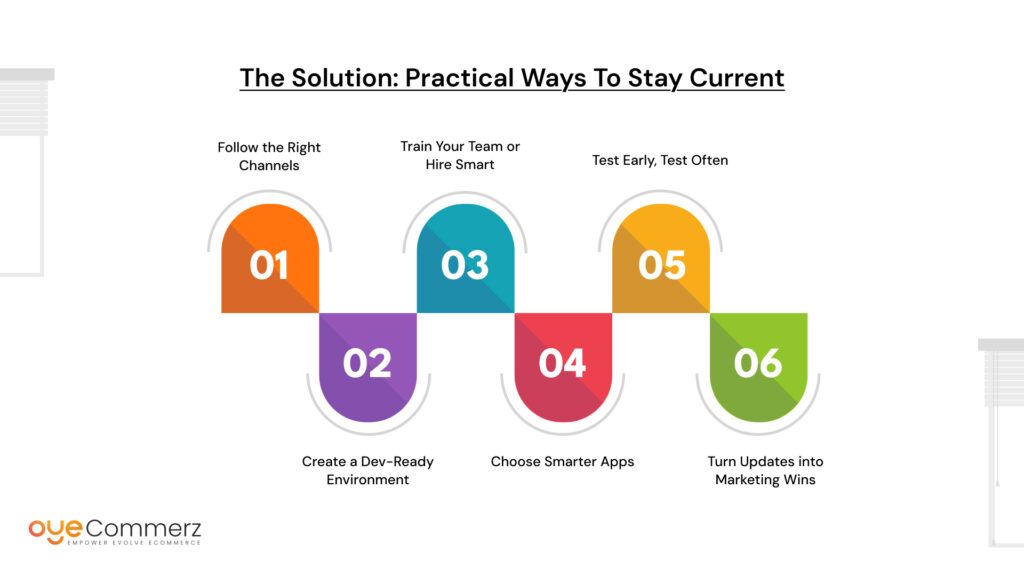
1. Follow the Right Channels
- Shopify Changelogs: Bookmark Shopify’s changelog page to stay informed about every platform tweak.
- Shopify Editions: These biannual updates showcase major launches. Subscribe and set alerts for their release.
- Partner & Developer Blog: Learn how backend changes affect front-end experience.
By creating a simple system to monitor these updates, you’ll always know what’s coming and how it could apply to your business.
2. Create a Dev-Ready Environment
- Use Development Preview Stores: Set up a dev store to test new features without affecting your live storefront.
- Assign a ‘Shopify Lead’ on your team or work with a certified Shopify Partner to stay on top of changes and ensure compatibility with your store setup.
3. Train Your Team or Hire Smart
- In-house training: Upskill your team with Shopify Academy or community webinars.
- Hire partners who build with Shopify’s ecosystem in mind, not generic web developers who might ignore updates or headless architecture like Hydrogen.
When your team speaks Shopify, your store speaks of success.
4. Choose Smarter Apps
- Avoid “set it and forget it” plugins.
- Instead, use apps that evolve with Shopify’s latest APIs, support Online Store 2.0, and regularly release updates to match Shopify’s infrastructure.
Pro tip: Apps like Klaviyo, ReConvert, Yotpo, and Loop are known to move in sync with Shopify updates.
5. Test Early, Test Often
- Don’t wait for features to become mainstream. If Shopify launches AI-based product descriptions or checkout enhancements, pilot them on a small segment first.
- Use Shopify’s A/B testing tools or app integrations to measure impact before a full rollout.
Agile adoption can offer a major head start.
6. Turn Updates into Marketing Wins
New feature? Tell your customers.
- Launch a blog or email update about your new lightning-fast checkout or personalized homepage.
- Frame it as part of your brand’s ongoing investment in their shopping experience.
By showcasing Shopify’s innovation as part of your brand promise, you build trust and signal momentum.
Adaptation isn’t about chasing every update. It’s about building a system that helps you absorb what matters, apply it fast, and keep evolving. Shopify gives you the tools. Now it’s your turn to stay sharp, stay agile, and stay ahead.
From Beginner to Advanced- What to Track in Every Update
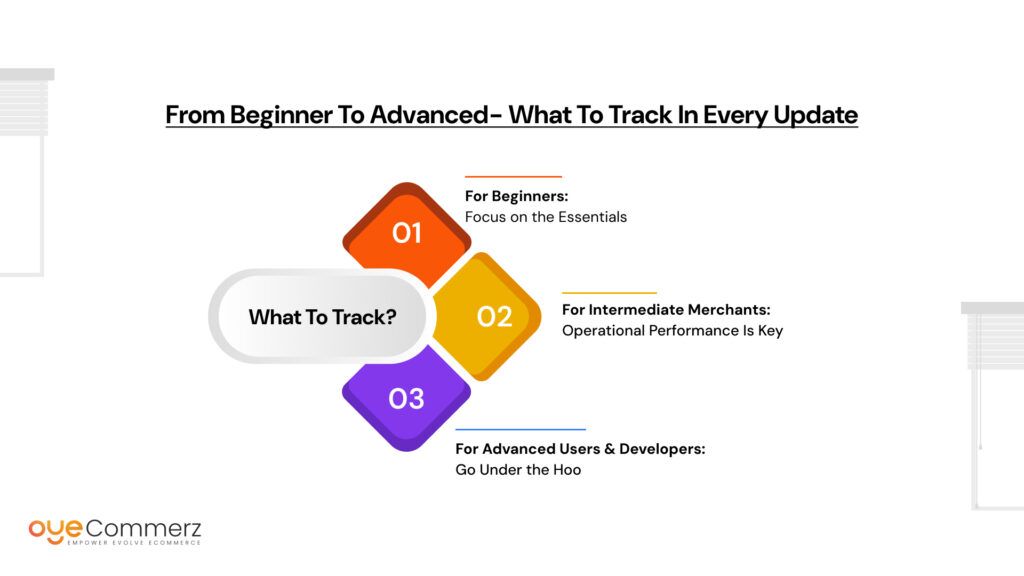
Shopify’s product update frequency isn’t just a signal of innovation, it’s a user guide for growth. But with dozens of updates rolling out throughout the year, how do you know which ones matter for you?
Not every update is for every user. Whether you’re a beginner just launching your store or a seasoned developer managing high-volume sales, your priorities will differ. The key is knowing where to focus, how to track, and when to act.
Let’s break it down.
For Beginners: Focus on the Essentials
If you’re new to Shopify, avoid getting lost in technical jargon. Concentrate on updates that directly impact the shopping experience.
- User Experience (UX): Look for design improvements, theme enhancements, and accessibility features.
- Payments: Keep an eye on new options like Shop Pay Installments or new U.S. payment gateway integrations.
- Mobile Optimization: With mobile traffic dominating U.S. e-commerce, updates improving mobile speed or layouts are critical.
- Store Speed: Shopify often releases performance boosts, adopting these ensures smoother navigation and higher conversion rates.
Tip: Bookmark Shopify’s “Editions” landing page and focus on the top 5 merchant-facing updates from each release.
For Intermediate Merchants: Operational Performance Is Key
If you’ve been running a store for over a year, you likely use apps, analytics tools, and more complex workflows.
Start tracking updates in these areas:
- App Compatibility: New API releases can break or enhance your apps. Make sure key apps you rely on evolve with Shopify.
- Checkout Flow: Watch for upgrades to checkout extensibility, custom fields, or performance enhancements, these can lift conversion rates.
- Customer Data Tools: Any update affecting CRM, segmentation, or analytics (especially if integrated with apps like Klaviyo or Shopify Email) should be evaluated for marketing gains.
Best Practice: Designate someone to read monthly changelogs and summarize changes relevant to your store stack.
For Advanced Users & Developers: Go Under the Hood
Advanced merchants and technical teams should monitor deep platform changes to unlock full customization power.
Track updates related to:
- Shopify Functions: These serverless functions allow deep backend customization, watch for expanded use cases.
- Liquid Enhancements: Shopify’s templating language evolves frequently. New filters or objects can power smarter themes.
- App Bridge Updates: These affect embedded app behavior in the Shopify admin panel.
- GraphQL API Evolutions: Faster queries and new endpoints can improve data workflows or app performance.
Developer Tip: Use the Shopify Developer Changelog for highly technical insights.
Build an Internal Update Checklist
To stay organized and aligned, create a recurring process:
- Is this update relevant to our store size or niche?
- Does it impact speed, checkout, customer experience, or ops?
- Can it give us a competitive edge now, or should we wait?
- Are our apps and themes compatible with the change?
Monthly Cadence Tip: Review, Reflect, React
Block time monthly, 15 to 30 minutes, for a “Shopify Update Review” session with your team. Use this time to:
- Review changes
- Identify opportunities
- Assign action steps
This habit alone can keep your store in tune with Shopify’s rapid evolution, and ahead of the competition.
Adaptation isn’t about chasing every feature. It’s about disciplined tracking, smart adoption, and staying lean enough to move fast.
Ready to keep pace with Shopify’s lightning-fast evolution?
At OyeCommerz, we specialize in Shopify services that help you stay ahead of every product update. From integrating new features to optimizing your store for the latest innovations, our experts have you covered. Don’t let your competitors move faster, partner with OyeCommerz and future-proof your e-commerce success today.
Contact to Migrate your Site to Shopify Now
Conclusion
Shopify’s product update frequency isn’t just impressive, it’s a clear blueprint for how to thrive in today’s digital economy. It reflects the pace of e-commerce innovation and signals where the market is headed. For U.S.-based merchants, every update is a signal and an invitation, to refine, to scale, and to outperform.
These aren’t just backend tweaks, they’re strategic enhancements that, when leveraged correctly, can drive real growth. But staying ahead means more than just noticing changes, it means actively engaging with them. That’s where expert Shopify services come in. From implementing new features to optimizing store performance, support from a knowledgeable team can make all the difference.
Frequently Asked Questions
As of 2024, Shopify powers around 10% of U.S. e-commerce, making it the second-largest platform after Amazon.
E-commerce will become more mobile-first, AI-driven, and hyper-personalized, with faster checkouts, sustainability focus, and global cross-border selling becoming standard.
Incremental Innovation – Small improvements to existing products
Disruptive Innovation – New products that change the market
Radical Innovation – Groundbreaking products that create entirely new industries
It’s a plan to develop new or improved products that meet market demands, giving businesses a competitive edge and driving growth.
To solve problems, meet evolving customer needs, improve efficiency, and gain market advantage in a rapidly changing environment.

